Modeling of Dual-Spinning Projectile with Canard and Trajectory Filtering
Abstract
The article establishes a seven-degree-of-freedom projectile trajectory model for a new type of spinning projectile. Based on this model, a numerical analysis is performed on the ballistic characteristics of the projectile, and the trajectory of the dual-spinning projectile is filtered with the unscented Kalman filter algorithm, so that the measurement information of projectile onboard equipment is more accurate and more reliable measurement data are provided for the guidance system. The numerical simulation indicates that the dual-spinning projectile is mainly different from the traditional spinning projectile in that a degree of freedom is added in the direction of the axis of the projectile, the forebody of the projectile spins at a low speed or even holds still to improve the control precision of the projectile control system, while the afterbody spins at a high speed maintaining the gyroscopic stability of the projectile. The trajectory filtering performed according to the unscented Kalman filter algorithm can improve the accuracy of measurement data and eliminate the measurement error effectively, so as to obtain more accurate and reliable measurement data.
1. Introduction
With the technical development of weapons, basic requirements of modern weapon systems are low collateral damage and accuracy. Currently, the great stocks of uncontrolled spin-stabilized projectiles in various countries are gradually being converted to precision-guided and controlled projectiles. Spin-stabilized projectiles maintain stability in flight through high-speed spinning. In order to deal with the challenges to measurement and control systems caused by high-speed spinning, drag increasing mechanisms, spinning reducing mechanisms, pulse engines and built-in sliders, and similar components are currently used as actuators to reduce fall point dispersion effectively. However, the drawback is that a continuous control force cannot be applied and precision strikes are difficult to achieve.
At present, a canard-guided dual-spinning projectile [1–11] has been converted to a controlled spinning projectile with great development potential. It can be used for continuous control to realize precision strikes. Furthermore, the great amount of uncontrolled projectiles currently stored can be modified into precise missiles only if fuzes of the traditional uncontrolled spin-stabilized projectiles are changed into canard-guided despinning fuzes. The dual-spinning projectile consists of two parts, that is, a forebody (with canards) and an afterbody, and the two parts are connected through a ball bearing. During flight, the forebody spins at a low speed (several or about a dozen turns per second), and the afterbody spins at a high speed (hundreds of turns per second) around the vertical axis, which gives rise to the term “dual-spin.” The low spinning speed of the forebody can make the measurement of related parameters and design of the control system more precise, and the high spinning speed of the afterbody allows maintaining the gyroscopic stability of the projectile, achieving a stable flight. A structural diagram of a dual-spinning projectile is shown in Figure 1.

During flight, since the projectile is affected by factors such as the environment, certain errors will inevitably be caused in the measurement system. With accumulation of these errors, the precision of the control system will be greatly affected. Trajectory filtering based on flight measurement data is an important means to understand the actual flight status of the projectile. It is widely applied in fields such as simulated flight model validation, emplacement reconnaissance amending, and trajectory prediction and filtering [12, 13]. At present, extended Kalman filtering (EKF) is widely applied in fields such as trajectory reconstruction and filtering. EKF is a linearization method for the nonlinear estimation problem. The linearization process will produce certain errors; it is difficult to find out the Jacobi matrix in its analytical form for the dual-spinning projectile model; there also has a heavy calculation burden. In order to overcome the shortcomings of EKF and avoid the error-prone and calculation-heavy Jacobi matrix, reconstruction and filtering of the dual-spinning projectile’s trajectory in this article is performed using the unscented Kalman filter (UKF) [14–16].
2. Seven-Degree-of-Freedom Mathematical Model of Dual-Spinning Projectile
Since the spinning speeds of the forebody and the afterbody of a dual-spinning projectile are different in the direction of the axis of the projectile, one degree of freedom (DOF) is added to the six-DOF rigid body dynamic model, which is used as a basis. Therefore, a seven-DOF dynamic model of the dual-spinning projectile is established in this article. This model comprises a centroid motion caused by the resultant force and rotation around the centroid caused by the resultant moment.
2.1. Coordinate System
The coordinate system of the axis of the projectile is as follows: The origin o is the location of the centroid, the axis direction along the nose of the projectile is the ox axis, the axis pointing rightward at a right angle to the axis of the projectile is the oy axis, and the oz axis is determined according to the right-hand rule. Figure 2 is the schematic diagram of the coordinate system.
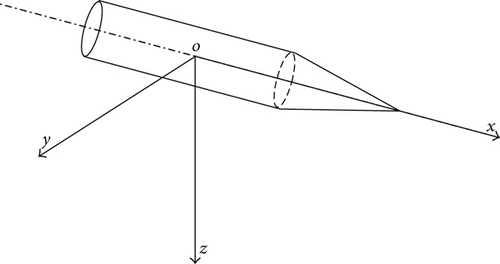
2.2. Dynamic Model

In (1) and (2), m is the total mass of the projectile; (u, v, w) are the velocity components, respectively; (X, Y, Z) are the resultant force components of the aerodynamic force, the canard-guided control force, and the resultant force of the Magnus force and gravity, respectively; (pf, pa, q, r) are the rotation speed components, where pf is the rotation speed of the forebody and pa is the rotation speed of the afterbody; (Lf, La, M, N) are the moment components of the afterbody, where Lf indicates the rolling moment of the forebody and La indicates the rolling moment subjected contributed by the afterbody; while I is the moment of inertia matrix.
2.3. Kinematic Model

In (3) and (4), (xe, ye, ze) are the coordinate components in the ground coordinate system and (ϕf, ϕa, θ, ψ) are the roll angle of the forebody, the roll angle of the afterbody, the pitch angle, and the yaw angle of the projectile body, respectively.
2.4. Force and Moment on Projectile
2.4.1. Force on Projectile
2.4.2. Moment on Projectile



3. Trajectory Characteristics
3.1. Trajectory Characteristics Simulation
According to the above model, a computer simulation program was developed to perform trajectory simulation. The basic physical parameters and aerodynamic parameters of the projectile are shown in Table 1. Launching conditions are as follows: the initial velocity was 930 m/s, the firing angle was 65°, and the canards opened at the 30th second. The trajectory characteristics simulation in this part was chosen so as to validate the correctness of the seven-DOF projectile trajectory model and form the basis for the subsequent analysis, and thus, only simulation results of coordinate and velocity data are presented herein. In order to distinguish the difference from traditional projectiles, simulation data of spinning speeds of the forebody and the afterbody are provided in this part.
| Parameter | Value | Parameter | Value |
|---|---|---|---|
| m | 45.5 kg | Cypα | −0.039 |
| D | 155 mm | Cmα | 4.102 |
| L | 909 mm | Cmδ | 0.351 |
|
|
0.012 kg·m−2 | Cnpα | 0.006 |
|
|
0.133 kg·m−2 | Clpf | −0.023 |
| Iy | 1.800 kg·m−2 | Clpa | −0.002 |
| CA | 0.352 | Cmq | −1.125 |
| CYβ | −2.012 | ks | 0.001 |
| CNδ | 3.121 | kv | 0.00001 |
3.2. Trajectory Characteristics Analysis
Figures 3–7 show curves of the velocity component, ballistic trajectory, and spinning speed characteristics, respectively. It can be clearly seen from Figures 3–7 that the established model is correct. The canard wing opened at the 30th second of the flight time, and certain changes occur in the speed data, so that the ballistic trajectory of the controlled trajectory is affected, which indicates that the canard wing can correct the trajectory. If the canard wing performs actions according to a certain control input, the trajectory can be corrected, so as to realize precision strikes to the target.

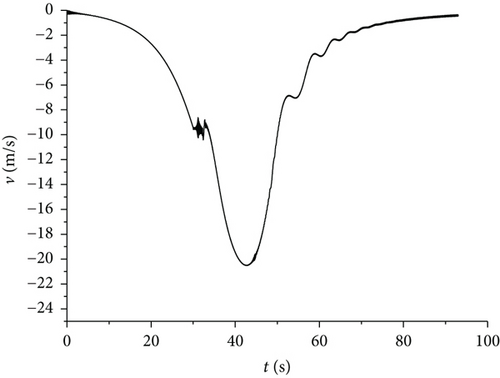

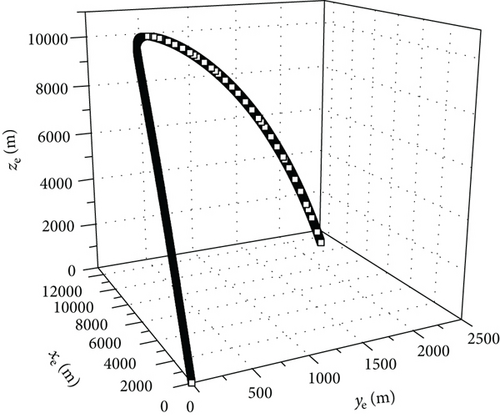
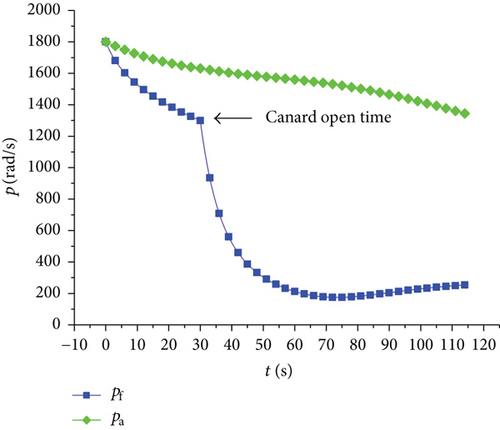
In order to illustrate the distinction between the dual-spinning projectile and the traditional spinning projectile, Figure 7 in particular provides the curve of speed data of the dual-spinning projectile. It can be seen from Figure 7 that speed of the afterbody shows free decay as the flight time passes, and it still maintains a high speed by the end of the flight, so as to guarantee the gyroscopic stability of the projectile during flight, allowing the projectile to be stable throughout the flight. The spinning speed of the forebody decays freely until the canard opened. Since the moment of inertia of the forebody is considerably less than that of the afterbody, the decrease in spinning speed in the free flight phase before the canard wing bounces off is greater than that of the afterbody. When the canard wing bounces off, the roll damping moment of the forebody increases rapidly, so that the spinning speed of the forebody decays rapidly. The low speed of the forebody is quite beneficial to the normal operation of the measurement and control systems, which is the expected result.
4. Trajectory Filtering
4.1. Construction of UKF Equation
The system model of the dual-spinning projectile is strongly nonlinear. If a linear filtering method, for example, KF or EKF, is applied, large linearization error will be caused. Moreover, system equations of seven-DOF are very complex, and it is hard to obtain the Jacobi matrix in analytical form, so in this article, the UKF is used to perform online trajectory reconstruction.
The steps for trajectory reconstruction using the UKF are the following.
4.1.1. Initialization
In (20), (21), (22), and (23), subscripts 0 and i of the weighting factor correspond to 2na + 1 sigma points. na is the dimension of state vector, λ is the parameter of the composite scale, η is the major scale factor determining distribution scope of sigma points around the priori mean, and the typical value is (10−3, 1), while ε is the second scale factor for stressing weights of the zero-order sigma points for calculation of posterior covariance (for Gaussian distribution, the optimal is ε = 2), and κ is the third scale factor, which is usually taken as 0. In this article, we assume that the process noise and measurement noise are both zero-mean Gaussian white noise, the process noise covariance matrix is Q, and the measurement noise covariance matrix is R.
4.1.2. Calculating Sigma Point and Updating
4.1.3. Measurement Updating
4.2. Simulation Verification
The trajectory filtering method based on the algorithm given in this article was validated. The validation conditions were as follows: the projectile initial speed was 930, the firing angle was 65°, and the projectile weight was 45.5 kg. The measured trajectory value was simulated by adding Gaussian white noise to the theoretical calculating value of the trajectory. Based on this measured value, the effectiveness of the UKF algorithm in the process of trajectory filtering was verified. Figures 8–10 show comparison curves of measurements and reconstruction values of xe, ye, and ze, respectively. It can be seen from Figures 8–10 that the precision of measurement data of the ballistic trajectory filtering through the UKF algorithm was significantly improved and is suitable for engineering applications.
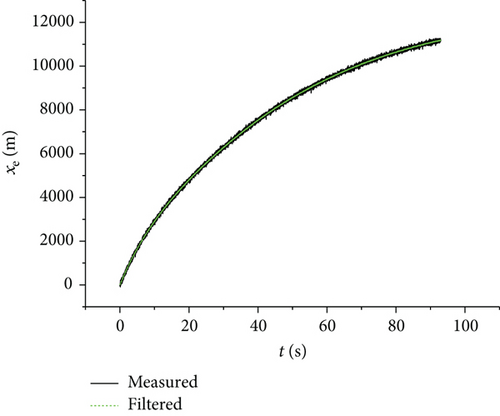
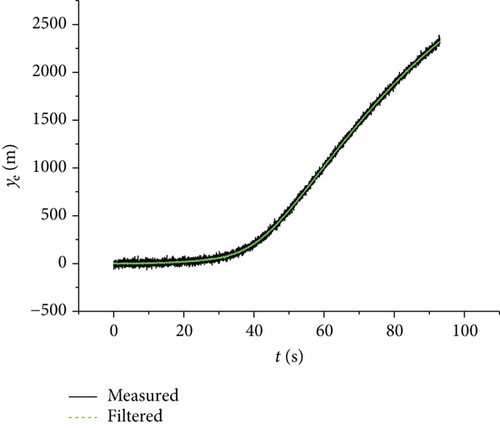
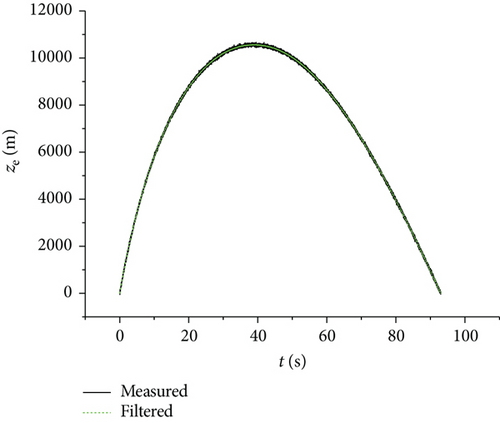
5. Conclusions
The article establishes a seven-DOF projectile trajectory model of a dual-spinning projectile. After analyzing the ballistic characteristics of the dual-spinning projectile with the method of numerical simulation, it can be seen that the major distinction between the dual-spinning projectile and the traditional spinning projectile is that the forebody and the afterbody show different spinning speed characteristics. This article specifically analyzes the reason causing this phenomenon and advantages for using such a structure. Furthermore, in this article, filtering the trajectory of the dual-spinning projectile is performed by using the UKF algorithm. Based on the comparison of the ballistic trajectory data before and after filtering, it can be seen that the precision of the measurement data is further improved, which can provide more accurate and reliable basic data for engineering applications.
Conflicts of Interest
The authors declare that they have no competing interests.
Acknowledgments
This work is supported by the National Natural Science Foundation of China under grant number 11472136.




